
Echinacea is a genus of herbaceous flowering plants in the daisy family. It has ten species, which are commonly called coneflowers. They are found only in eastern and central North America, where they grow in moist to dry prairies and open wooded areas. They have large, showy heads of composite flowers, blooming in summer. The generic name is derived from the Greek word ἐχῖνος, meaning "hedgehog", due to the spiny central disk. These flowering plants and their parts have different uses. Some species are cultivated in gardens for their showy flowers. Two of the species, E. tennesseensis and E. laevigata, were formerly listed in the United States as endangered species; E. tennesseensis has been delisted due to recovery and E. laevigata is now listed as threatened.

Echinacea tennesseensis, also known as the Tennessee coneflower or Tennessee purple coneflower, is a flowering plant in the family Asteraceae, endemic to the cedar glades of the central portion of the U.S. state of Tennessee.

Rudbeckia fulgida, the orange coneflower or perennial coneflower, is a species of flowering plant in the family Asteraceae, native to eastern North America.

Microseris is a genus of plants in the tribe Cichorieae within the family Asteraceae, plants that often called composites. They are native to North America, South America, Australia, and New Zealand.

Echinacea purpurea, the eastern purple coneflower, purple coneflower, hedgehog coneflower, or echinacea, is a North American species of flowering plant in the family Asteraceae. It is native to parts of eastern North America and present to some extent in the wild in much of the eastern, southeastern and midwestern United States as well as in the Canadian Province of Ontario. It is most common in the Ozarks and in the Mississippi/Ohio Valley. Its habitats include dry open woods, prairies and barrens.
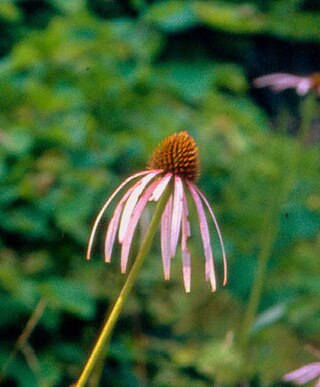
Echinacea laevigata, the smooth purple coneflower, is a federally listed threatened species of plant found in the Piedmont of the eastern United States. Most populations are found on roadsides and other open areas with plenty of sunlight, often on calcium- and magnesium- rich soils.
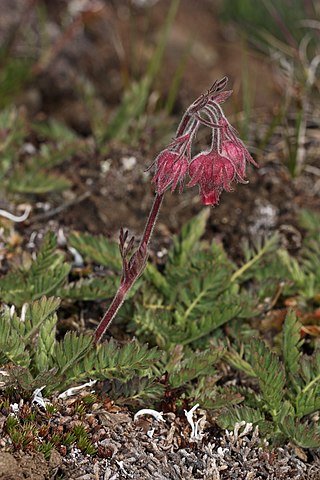
Geum triflorum, commonly known as prairie smoke, old man's whiskers, torchflower, three-sisters, long-plumed purple avens, lion's beard, or three-flowered avens, is a spring-blooming perennial herbaceous plant of the Rosaceae family. It is a hemiboreal continental climate species that is widespread in colder and drier environments of western North America, although it does occur in isolated populations as far east as New York and Ontario. It is particularly known for the long feathery plumes on the seed heads that have inspired many of the regional common names and aid in wind dispersal of its seeds.
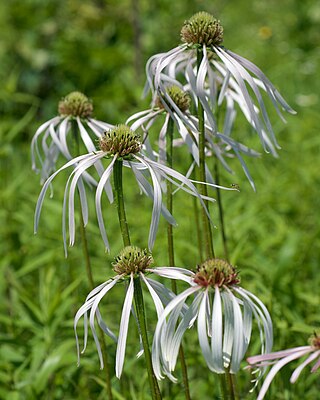
Echinacea pallida, the pale purple coneflower, is a species of herbaceous perennial plant in the family Asteraceae. It is sometimes grown in gardens and used for medicinal purposes. Its native range is the central region of the United States and Ontario, Canada.

Echinacea simulata, commonly called wavy leaf purple coneflower, glade coneflower, or prairie purple coneflower, is a species of perennial flowering plant in the family Asteraceae. It is native to the east-central states of the United States. Its natural habitat is dry, calcareous, open areas such as barrens and woodlands.

Symphyotrichum laeve is a flowering plant native to Canada, the United States, and Coahuila (Mexico). It has the common names of smooth blue aster, smooth aster, smooth-leaved aster, glaucous Michaelmas-daisy and glaucous aster.
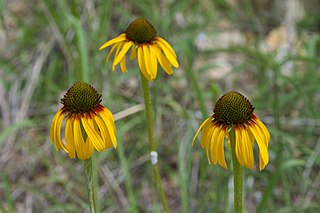
Echinacea paradoxa, the yellow coneflower, Bush's purple coneflower, or Ozark coneflower, is a North American species of flowering plant in the family Asteraceae. It is native to southern Missouri, Arkansas, and south-central Oklahoma, It is listed as threatened in Arkansas.

Symphyotrichum sericeum is a species of flowering plant in the family Asteraceae native to central North America. Commonly known as western silver aster, western silvery aster, and silky aster, it is a perennial, herbaceous plant that may reach 70 centimeters tall. Its flowers have purple ray florets and pink then purple disk florets, and its leaves are firm and silvery-green.
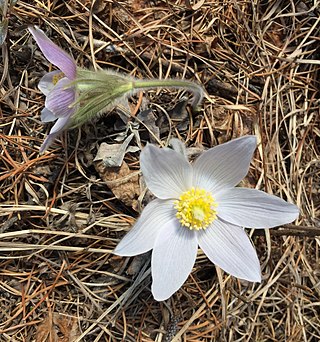
Pulsatilla nuttalliana, known as American pasqueflower, prairie pasqueflower, prairie crocus, or simply pasqueflower, is a flowering plant native to much of North America, from the western side of Lake Michigan, to northern Canada in the Northwest Territories, south to New Mexico in the southwestern United States. Pasqueflower is the provincial flower of Manitoba and the state flower of South Dakota.

Ratibida pinnata is a species of flowering plant in the family Asteraceae known by the common names pinnate prairie coneflower, gray-head coneflower, yellow coneflower, and prairie coneflower. It is native to the central and eastern United States and Ontario in Canada.

Symphyotrichum georgianum is a rare species of flowering plant in the Asteraceae, the aster family. Its common name is Georgia aster. It is native to the southeastern United States where it is known from Alabama, Florida, Georgia, North Carolina, and South Carolina. As of 2013, it may be extirpated from the state of Florida.

Symphyotrichum falcatum is a species of flowering plant in the family Asteraceae. Commonly called white prairie aster and western heath aster, it is native to a widespread area of central and western North America.

Mertensia lanceolata, known as prairie bluebells, narrow-leaved languid lady, lance-leaved bluebells, and lance-leaved lungwort is a species of flowering plant native to western North America. A herbaceous perennial it has blue-green leaves alternately arranged on its smooth flowering stalk. Its flower buds are pink-purple and become more blue as they open. Accepted varieties include:

Symphyotrichum chapmanii is a species of flowering plant in the family Asteraceae native to the Apalachicola River drainage basin of Alabama and Florida. Commonly known as savanna aster, it is a perennial, herbaceous plant that may reach 30 to 80 centimeters tall. Its flowers have purple to blue-lavender ray florets and pale yellow disk florets. It is a wetland species and is of conservation concern. It may be extirpated in Alabama.

Symphyotrichum divaricatum is an annual and herbaceous plant commonly known as southern annual saltmarsh aster. It is native to the southern United States and some northern states of Mexico.

Penstemon ambiguus, commonly known as the bush penstemon, pink plains penstemon, or gilia beardtongue is a species of Penstemon that grows in the shortgrass prairies and deserts of the western United States and northern Mexico. This bush like penstemon grows in sandy, loose, and creosote soils and is particularly known for the spectacular flowering show it produces, sometime seasons turning whole hillsides bright pink–white.























